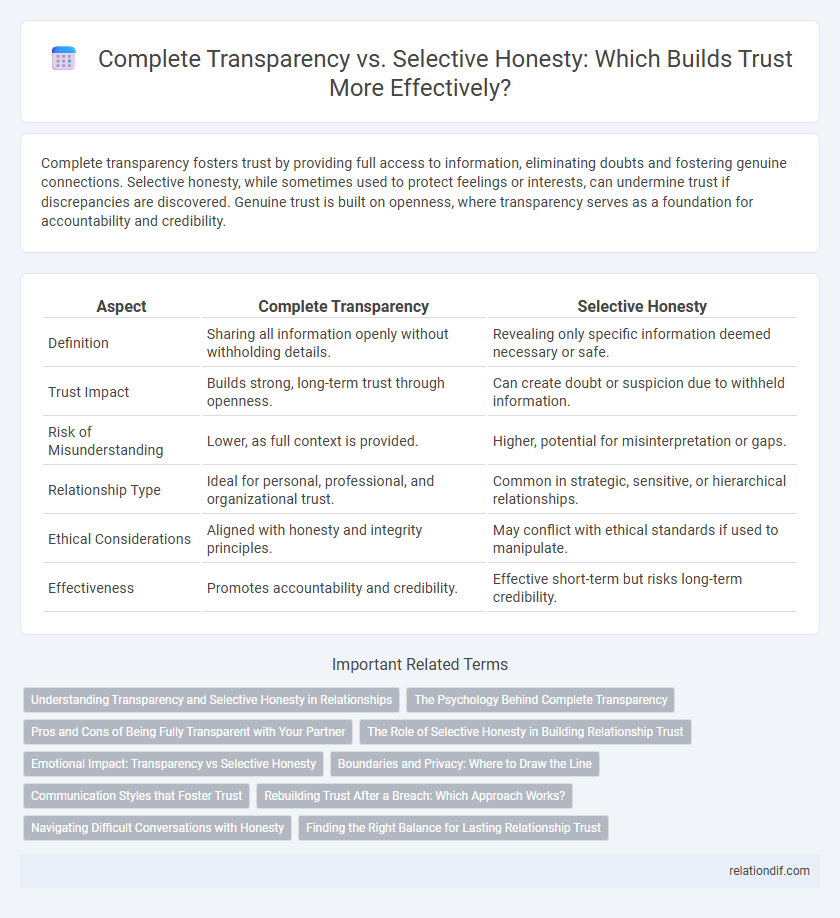Complete transparency fosters trust by providing full access to information, eliminating doubts and fostering genuine connections. Selective honesty, while sometimes used to protect feelings or interests, can undermine trust if discrepancies are discovered. Genuine trust is built on openness, where transparency serves as a foundation for accountability and credibility.
Table of Comparison
| Aspect | Complete Transparency | Selective Honesty |
|---|---|---|
| Definition | Sharing all information openly without withholding details. | Revealing only specific information deemed necessary or safe. |
| Trust Impact | Builds strong, long-term trust through openness. | Can create doubt or suspicion due to withheld information. |
| Risk of Misunderstanding | Lower, as full context is provided. | Higher, potential for misinterpretation or gaps. |
| Relationship Type | Ideal for personal, professional, and organizational trust. | Common in strategic, sensitive, or hierarchical relationships. |
| Ethical Considerations | Aligned with honesty and integrity principles. | May conflict with ethical standards if used to manipulate. |
| Effectiveness | Promotes accountability and credibility. | Effective short-term but risks long-term credibility. |
Understanding Transparency and Selective Honesty in Relationships
Complete transparency involves openly sharing thoughts, feelings, and actions without withholding information, fostering deep trust and emotional intimacy in relationships. Selective honesty, while sometimes used to protect feelings or avoid conflict, can create uncertainty and erode trust over time if important details are consistently omitted. Understanding the balance between transparency and selective honesty is crucial for maintaining healthy communication and ensuring mutual respect in personal connections.
The Psychology Behind Complete Transparency
Complete transparency fosters trust by eliminating uncertainty and promoting psychological safety through openness and vulnerability, which enhances interpersonal connections. Psychological studies show that when individuals are fully transparent, it reduces cognitive dissonance and builds credibility, leading to stronger, more resilient relationships. However, selective honesty can trigger suspicion and erode trust over time, highlighting the psychological importance of consistent and complete transparency in social and professional interactions.
Pros and Cons of Being Fully Transparent with Your Partner
Being fully transparent with your partner fosters deep trust and emotional intimacy by eliminating secrets and promoting open communication. However, it may also lead to vulnerability, potential misunderstandings, and conflicts if sensitive information is not communicated thoughtfully. Balancing honesty with empathy is essential to maintain a healthy, trusting relationship while protecting each other's feelings.
The Role of Selective Honesty in Building Relationship Trust
Selective honesty strategically shares information to foster trust without overwhelming or alienating others, balancing openness with discretion. This approach allows individuals to maintain credibility while protecting sensitive details, enhancing long-term relationship stability. Research shows that carefully calibrated honesty improves communication effectiveness and nurtures emotional safety in interpersonal connections.
Emotional Impact: Transparency vs Selective Honesty
Complete transparency fosters deep emotional security by building unwavering trust and reducing anxiety through open communication, while selective honesty often leads to doubts, confusion, and emotional distance due to hidden information. Transparent interactions promote empathy and stronger bonds by validating feelings and encouraging vulnerability. In contrast, selective honesty may undermine emotional connections, triggering feelings of betrayal and insecurity within relationships.
Boundaries and Privacy: Where to Draw the Line
Balancing complete transparency with selective honesty requires clear boundaries to protect personal privacy while maintaining trust. Establishing limits on the information shared ensures respect for confidentiality without fostering suspicion or deceit. Trust thrives when individuals honor these boundaries, allowing openness in appropriate contexts while safeguarding sensitive details.
Communication Styles that Foster Trust
Complete transparency in communication cultivates trust by promoting openness and accountability, allowing all parties to access essential information without filters. Selective honesty may protect short-term interests but risks eroding trust due to perceived deception or withholding critical details. Communication styles that emphasize clarity, consistency, and full disclosure strengthen relational trust and encourage collaborative problem-solving.
Rebuilding Trust After a Breach: Which Approach Works?
Rebuilding trust after a breach requires a strategic balance between complete transparency and selective honesty, where complete transparency fosters accountability by openly addressing mistakes and corrective actions, while selective honesty may protect sensitive information but risks further distrust if perceived as concealment. Research from the Harvard Business Review indicates that organizations embracing full transparency see a 30% higher likelihood of restoring employee and customer trust within six months compared to those practicing selective disclosure. Implementing comprehensive communication strategies that prioritize openness helps rebuild reputational capital and strengthens long-term relationships.
Navigating Difficult Conversations with Honesty
Navigating difficult conversations with honesty requires balancing complete transparency and selective honesty to maintain trust without causing unnecessary harm. Emphasizing clear communication and empathy allows individuals to disclose essential information while respecting boundaries, fostering a sense of safety and understanding. Prioritizing trust-building through consistent, transparent dialogue enhances relationship resilience and promotes long-term collaboration.
Finding the Right Balance for Lasting Relationship Trust
Complete transparency fosters trust by creating an open environment where all information is shared honestly, but it can sometimes overwhelm or hurt feelings. Selective honesty protects sensitive information and preserves harmony, yet excessive withholding can lead to suspicion and erode trust over time. Finding the right balance involves sharing meaningful truths while respecting boundaries, cultivating trust that supports enduring and authentic relationships.
Complete transparency vs selective honesty Infographic

 relationdif.com
relationdif.com